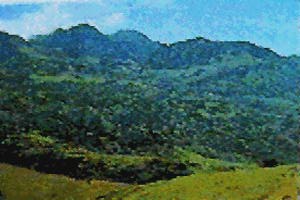
The eastern border of Zimbabwe is dominated for 187 miles by hills and mountains that form the edge of the central plateau and are known collectively as the Eastern Highlands. They extend from the rolling downlands and steep scarps of Nyanga in the north to the sheer quartzite cliffs of the Chimanimani Mountains in the south.
The highlands are a popular holiday area for Zimbabwean residents, providing trout fishing, impressive scenery and relief from the summer heat of lower-lying areas. They are also becoming popular with overseas tourists and several international-class hotels, offering a wide range of recreational facilities such as golf, bowls and horse riding, are located in the region.
A generally equable climate has combined with a high annual rainfall to produce an interesting flora and an area which has become a highly specialised agricultural centre for horticultural crops, tea, coffee and forestry.
A good system of tarred roads connects major centres in the region and provides access to Nyanga National Park, Mtarazi Falls National Park, Vumba Botanical Gardens, Bunga Forest Botanical Reserve, Chimanimani National Park, Chimanimani Eland Sanctuary and Chirinda Forest Reserve.
Northern area
The most northerly of these conservation areas, Nyanga National Park, was among the first national parks to be declared in Zimbabwe. It contains features such as Inyangani, at 8 501 feet the country's highest mountain, and the spectacular Pungwe Falls and Gorge.
The adjoining Mtarazi Falls National Park was established to protect the country's highest waterfall, which plunges for 2 499 feet into the Honde Valley.
The Nyanga area is rich in history. There is plentiful archaeological evidence to indicate that it has been occupied almost continuously since the Stone Age while Portuguese records from the 16th century refer to it as one of the subdivisions of the Munhumutapa kingdom (see Nyanga archaeolgical sites).
The dams in the area are stocked with trout by local hatcheries and the quality of the trout fishing in the area attracts many anglers (see Nyanga dams). The downs are popular with walkers and climbers and provide many spectacular views. Those from the summit of Inyangani, across the Mozambique lowlands, and from World's View are especially impressive.
Central and southern area
The city of Mutare, 62 miles south of Nyanga, is the main urban centre within the Eastern Highlands. Dominated by mountains on all sides, the city lies in a valley that creates a natural gateway between the Mozambique lowlands and the Zimbabwean interior.
Just outside the city boundary is the Cecil Kop Nature Reserve, which contains rare indigenous species such as blue duiker and samango monkeys and has an introduced population of local mammals, including the white rhinoceros.
Mutare has a diverse industrial base but serves mainly as a centre for activities related to forestry within the Eastern Highlands. Some large hectarages of timber, notably conifers, are grown in the region and Mutare's industries include sawmilling and the manufacture of paper and furniture. Wattle is also grown in the highlands region, and its bark is used in the tanning of leather and gameskins.
However, the uncontrolled spread of this introduced tree has become a considerable nuisance in conserved areas such as the Nyanga National Park.
Mutare provides easy access to the Vumba Botanical Gardens and the Bunga Forest Reserve. Both lie south of the city within the Vumba Mountains (the 'mountains of mists') where a yearly average rainfall of 65 inches has created areas of montane and cloud forest and a unique flora.
Further south, near the fertile farming area of Cashel Valley, the Vumba Mountains give way to the Chimanimani Mountains, the biggest and most impressive mountain range in Zimbabwe. Most of the range, which reaches a maximum altitude of 8003 feet, is contained within the Chimanimani National Park.
The only access to the mountains is on foot from the Chimanimani village. The mountains contain rare plant species of special interest to botanists and have become popular with experienced walkers and climbers.
The most southerly of the conserved areas within the highlands is the 2 345 acres Chirinda Forest Reserve, a fragment of primeval sub-tropical forest 19.9 miles south of the tea and coffee farming centre at Chipinge.
The reserve contains over 100 tree species, including the red mahogany, Khaya nyasica, some specimens of which are 196.8 feet high and 49 feet in circumference.
There is no regular scheduled air service to the Eastern Highlands but there are good communications by road from Harare, Bulawayo and the south. A regular passenger rail service runs between Harare and Mutare.